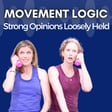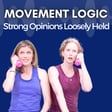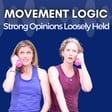
89: Is Dead Butt Syndrome Real?
In this episode of the Movement Logic Podcast, host Laurel Beversdorf explores the concept of 'dead butt syndrome' or 'gluteal amnesia', debunking both as a non-evidence-based myths perpetuated in fitness and health discussions. Laurel discusses the misleading information in a recent New York Times article titled Sitting All Day Can Cause Dead Butt Syndrome, and emphasizes the importance of evidence-based terms and ideas in understanding pain and body function. She outlines the dangers of accepting unsupported medical terms, advises on better exercise practices, and stresses the significance of regular, whole-body strength training for overall health. Listener feedback is also addressed, touching on the podcast's approach to myth-busting and health education.
00:00 Introduction and Personal Check-In
01:17 Understanding Dead Butt Syndrome
03:03 Debunking the Myth: Evidence and Expert Opinions
06:10 Critique of the New York Times Article
09:12 Addressing Listener Feedback
12:51 The Problem with Sensationalism in Media
16:45 The Complexity of Pain and Misleading Diagnoses
32:28 Exploring Gluteus Maximus Firing Patterns
33:11 Factors Predicting Athletic Injuries
33:48 Critiquing the New York Times Article
34:18 Debunking Gluteal Amnesia Myths
36:02 The Problem with Pathologizing Normal
44:23 Understanding Muscle Cramping
56:45 Effective Movement and Pain Prevention
58:23 Upcoming Classes and Courses
Free offerings mentioned in this podcast:
Take a free class with Laurel and get the replay - Escape the Gride: A Multi-Planar Banded Flow
Get on the Waitlist for Bone Density Course and get the only discount for Spring 2025 cohort
Get the free Bone Density Mini-Course: Barbell 101
Resources mentioned in this podcast:
Greg Lehman on "Trojan horsing"
Conspirituality Podcast on Post-Truth America
Sitting All Day Can Cause Dead Butt Syndrome
Have the Butt Muscles of the World Gone Silent?
Muscle Recruitment Patterns During the Prone Leg Extension
Test showing more gm activity in presence of pain
People with low back pain do not have a delayed firing of GM


